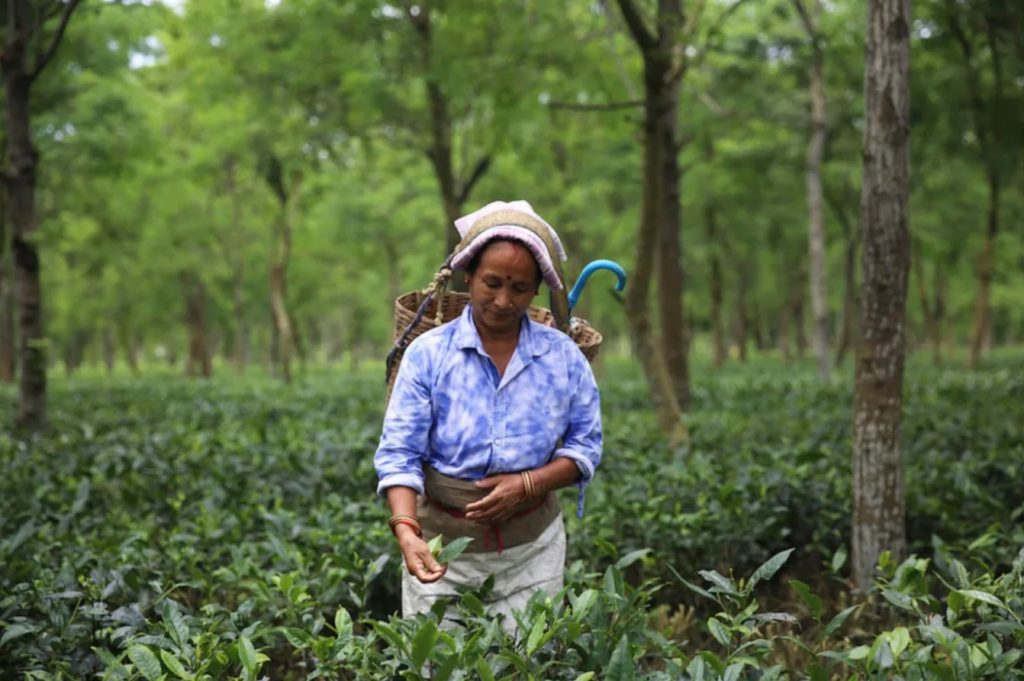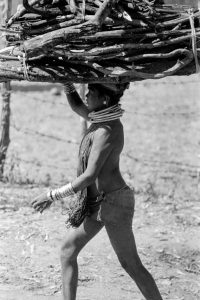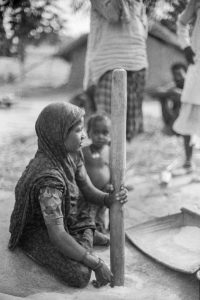Prachi Sahasrabudhe
Part 4- A Woman’s Work: The Question of gendered labour
Gendered labour is a reality in our country that cannot be denied. When it comes to specific types of work, such as domestic tasks or laborious activities in farming, tea plantations, etc., it is frequently thought of as a woman’s job; nevertheless, the men are regarded family’s breadwinners rather than a woman who prepares it. The photography of Cheena Kapoor and P. Sainath demonstrated a keen interest in the issue of gendered labour and the contribution of women in laborious chores that are frequently viewed as obligatory for women but are not acknowledged as significant.
Cheena Kapoor – Tea Plantation:
The enormous tea plantations in eastern India’s Dooars region formerly provided a living for area’s tribal people. The government pledged to investigate the difficulties of the plantation workers, but their situation has not improved. Delay in the approval of a bill guarantying a minimum wage for all workers in the country, the increase in market price of tea and the total expense of growing it, led many gardens to close at Dooars, pushing workers to seek alternative means of income.
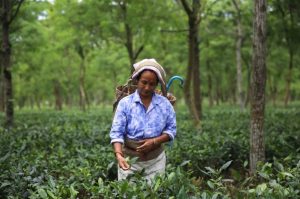
Hundreds of workers faced hardship and an unclear future as several tea estates shut down.
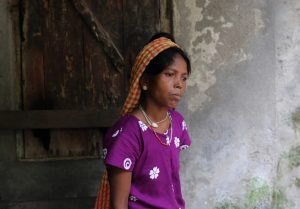
The Chuapara Tea Estate in West Bengal’s Jalpaiguri, staged a rebellion in July due to overcrowding in a school bus. According to an agreement in the 1980s, the garden management is responsible for providing school buses to the children, mainly girls, of tea garden workers.
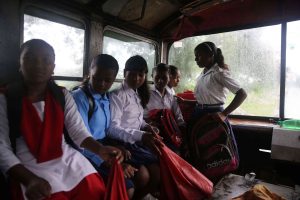
On July 1, 400 children blocked the roads through the garden, refusing to budge despite pleas from union uncles and parents. The management declared a lock-out soon after due to the children’s “temerity to create chaos and confusion”. The bus service was shut down pending a resolution. This episode initiated China Kapoor’s project to document the plight of labour in tea gardens. The Dooars, the doorway to the hills, experienced frequent closures of tea gardens, resulting in 1,200 people dying of hunger between 2002 and 2007. Garden workers faced starvation, child trafficking, and distress migration, but their plight was largely overlooked in the media. Cheena Kapoor’s photography project chronicled numerous heart-breaking anecdotes of the event’s repulsions on the families of tea garden workers, especially women.
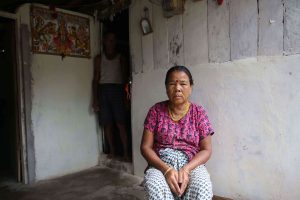
www.scroll.in
Umri was handed over to a broker for Rs 2,000 by her own son and sent to Nepal and Kuwait on forged papers to do domestic work. She was sent back after three years with no pay and now struggles to support herself and her husband with his mental health. Even yet, Umri considers herself fortunate because other people, including her sister, whom she has not heard from in several months, are still stranded abroad without the proper papers.
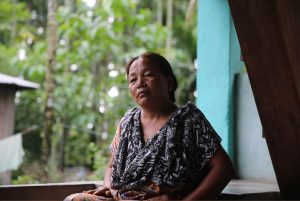
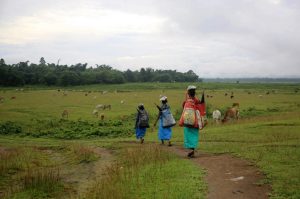
Dalmore Garden has battled to remain open all over the years. Traditionally, employment in the estates was classified by gender, with women picking leaves and men working in factories. However, because the men had relocated elsewhere, practically all the manufacturing workers in Dalmore were women. Ironically, all union representatives were male in an industry with an overwhelmingly female workforce.
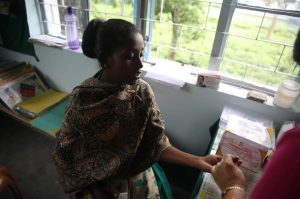
1. Sainath – Invisible women, visible work:
P Sainath’s images document the labour and lifestyles of Indian rural women, and were initially displayed in 2002 at an All-India Democratic Women’s Association convention. (AIDWA). The exhibition was mostly attended by rural poor people who would never be able to visit a gallery to view exhibitions. The show was part of the Chennai Photo Biennale, which took place at Fine Arts College in Egmore.
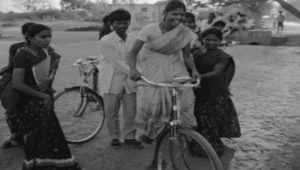
N Kannammal is one of the organisers of the Pudukkottai bicycle movement, which has altered her life and the lives of many others. Iyakkam at Arivoli refers to the ‘Light of Knowledge movement,’ in which they chose to integrate women’s mobility as part of their goal and announced competitions. At least 60,000 women took part, and one lakh women ended up teaching around one lakh women. Despite rude remarks and obscenities, the males chastised them for leading the women astray and laughed when they collapsed. As a result of the movement, native women may go to distant regions to further their education and are no longer reliant on males to travel locally. Kannammal is one of the many rural women included in the photographs of the exhibition – “Invisible Women, Visible Work: Women and Work in Rural India.” In one of the photos, she is showing a woman how to ride a bicycle. During a visit to Chennai, she is affected and intrigued by the exhibition, which is a testament to Arivoli Iyakkam’s success.
Four ladies from the village Budathanapalli in Vizianagaram district inaugurated the show with a song from the fields. The most significant event was that people from the village came in busloads to view it, and that agricultural workers unions and other organisations assisted in setting up a shamiana for the display. The show was curated by Dayanita Singh, one of the India’s best photographers, who filtered through hundreds of negatives and chose every image.
Since that time, the show travelled most of the country for several years. It has been displayed at railway stations, bus stops, workplace gates, and even in the neighbourhoods of some of the ladies themselves. The five sets were given to various groups, with one set ending up in the United States. Up to 2014, at least 7,00,000 people had seen them, and 38 comment volumes in various languages had been published. Most of the audience consisted of rural peasants, with females outnumbering males. The exhibition was seen by a diverse group of people, ranging from landless workers to university professors, and elicited a spectrum of opinions. One of the most emotional was in a Jaipur Women’s College, when a young
lady composed a two-to-three-page poem on the subject. The most rewarding aspect of the exhibition was that it was seen by the rural poor, who would never be able to visit a gallery to witness an exhibition. ‘Visible Work, Invisible Women’ is a picture exhibition that depicts the wide spectrum of work done by rural women. P. Sainath took the images between 1993 and 2002 in ten Indian states. It is a photo documentary project on the discrimination and invisibility that rural, working women in India face. The exhibition is now housed in the People’s Archive of Rural India (PARI), which Sainath founded. P Sainath’s photographs are focused, detailed, and expressive of his passion for the subject. The text that accompanied each image in the presentation added to its power.
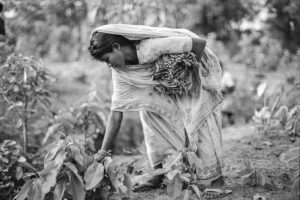
The Adivasi lady in the top image is picking tendu leaves in the Surguja forest in Chhattisgarh, where thousands of families do the same thing. Her six-member family may earn up to Rs. 90 on a good day. Tendu is vital to the Adivasi economy, as are mahua flower harvesting, tamarind gathering, cheronji, and sal. Adivasi communities in some regions of the nation rely on non-timber forest products (NTFP) for more than half of their income, although they only receive a portion of the product’s value. Nationally, NTFPs are valued approximately Rs. 15,000 crores, but for Adivasi women and their families, it means survival. The actual money is made by middlemen, dealers, moneylenders, and others.
Rural women are the primary source of non-timber forest produce. (NTFPs). She collects, processes, and promotes these items, which are already a multibillion-dollar worldwide business. The more forest lands are damaged, the more difficult her jobs become, as are her journeys and working hours. In Odisha, she walks three to four hours every day, and her workday is 15 hours long. She creates ropes, baskets, and brooms in Vizianagaram, Andhra Pradesh. The lady in Bundelkhand, Madhya Pradesh, is adaptable and maintains an incredible variety of items in her location, where the trees are nearly extinct. Her family’s situation is dreadful.
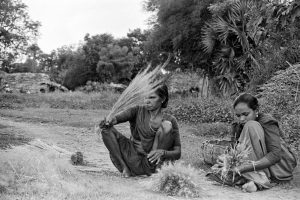
Women in rural India face difficult tasks such as bringing water, firewood, and fodder, which can consume up to one third of their lives. Privatisation and commercialisation of village commons is affecting the poor, mainly agricultural labourers, resulting in the destruction of ponds and walkways, grazing areas, firewood, fodder, and water for cattle. As a result, many women have lost access to latrines, which has become a major issue. Millions of homes rely on fuel, feed, and water, but those who undertake the work pay a high price.
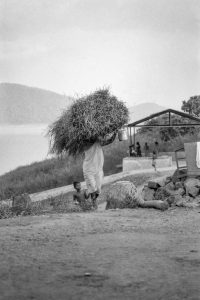
Home tasks include cooking, washing clothing, grinding, chopping vegetables, cleaning containers, and feeding various family members. These chores are considered “women’s work” and are never paid for, yet the great distances for water and fuel, as well as the nature of field work, add to the load on rural women.
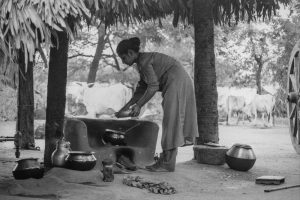
The pounding done by the lady in Ghazipur, Uttar Pradesh, requires significantly more strength and effort than it appears, and is one among several cooking or preparation jobs she is involved in. In Palamau, Jharkhand, Adivasi women spend most of their mornings in the jungle preparing getti roots for cooking. Women eat last and least, and they get very little. Women eat last and least, and get little rest, so these energy-sapping regimens have a devastating effect on their health.
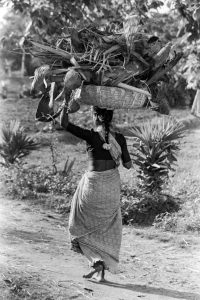
The lady in Bihar who rolls fuel lumps contributes to the national economy by collecting and producing cooking fuel from dung, which is an essential organic fertiliser used to raise crops. Women are estimated to make up 69-93% of the workforce in the dairy industry, but only 18% own and manage their own cattle. Poor people must sell their cattle or other livestock in order to exist, and women are responsible for the herd’s wellbeing.
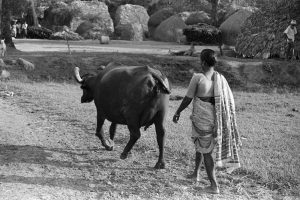
Another neighbour can be seen carrying the buffalo from the fields in the picture above. The animal has noticed a relatively little but formidable adversary, the little dog poised to snap at its legs, and is feeling a little uncomfortable. Despite having observed both indicators, the lady is in charge. She will take care of the buffalo and transport it safely home. like she did throughout her entire life.
- References:
- Cheena Kapoor, 18th September 2019, “In pictures : Plight of India’s tea plantation workers”, https://www.aljazeera.com/gallery/2019/9/18/in-pictures-plight-of-indias-tea plantation-workers
- Anirban Bhattacharya, Rupam Deb & Cheena Kapoor, 16th November 2019, “Photo feature : Struggle & hope in the tea gardens of the Dooars”, Scroll.in,
- https://scroll.in/article/940717/photo-feature-struggle-and-hope-in-the-tea-gardens-of-the dooars
- Kavita Muralidharan, 20th March 2019, “Invisible Women , Visible Work : P Sainath’s photos document the labour and lives of Indian rural women” , Firstpost,
- https://www.firstpost.com/living/invisible-women-visible-work-p-sainaths-photos-document the-labour-and-lives-of-indian-rural-women-6280631.html
- P. Sainath, 24 July 2014, “Visible work, Invisible Women: Visible work, Invisible Women, (Panel 5)”, Pari, People’s Archive of Rural India,
- https://ruralindiaonline.org/en/articles/visible-work-invisible-women-visible-work-invisible women-panel-5/
- P. Sainath, 23 July 2014, “Visible work, Invisible Women: And gathering their lives (Panel 6)”, Pari, People’s Archive of Rural India, https://ruralindiaonline.org/en/articles/and gathering-their-lives/
- P. Sainath, 23 July 2014, “Visible work, Invisible Women: Home again, home again… (Panel 8)”, Pari, People’s Archive of Rural India, https://ruralindiaonline.org/en/articles/visible work-invisible-women-home-again-home-again-panel-8/
- P. Sainath, 24 July 2014, “Visible work, Invisible Women: Till the cows come home (Panel 9A)”, Pari, People’s Archive of Rural India, https://ruralindiaonline.org/en/articles/visible work-invisible-women-till-the-cows-come-home-panel-9A/

